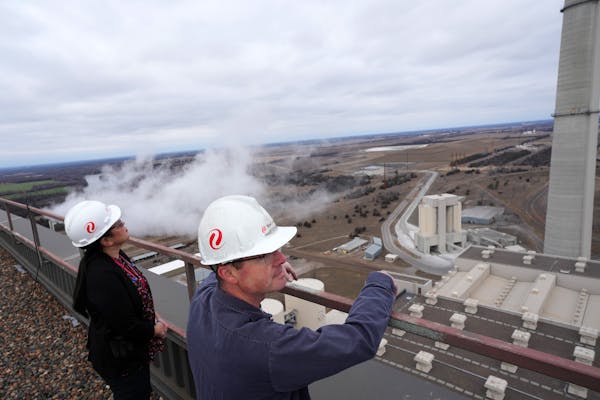Xcel Energy on Thursday said it wants to extend the life of its Prairie Island nuclear power plant by 20 years as well as significantly invest in large-scale battery storage and build two natural gas plants.
Along with investing even more in wind and solar plants, the long-term energy blueprint could significantly speed up the Minneapolis-based company's transition to a carbon-free footprint. If approved by Minnesota regulators, it also would drive a massive infrastructure investment.
The company declined to provide a cost for the plan, although many of the proposed projects could cost tens of millions of dollars.
While customers would foot part of the bill, Ryan Long, president of Xcel's Minnesota operations, said the plan would likely result in an average rate increase of less than 1% per year. He said the company expects to fund the improvements with $5.7 billion in anticipated savings in tax credits tied to the landmark federal Inflation Reduction Act.
The proposal comes at a pivotal moment in the energy transition for Xcel, which has begun retiring its coal fleet and will shutter its last unit by 2030, pushing the company to replace that steady power generation with renewables and keep its three nuclear units running.
"We're expected to exceed 80% carbon reduction by 2030, reaching potentially up to 88%," Long said.
Minnesota has set 2040 as the benchmark year to be carbon-free.
Isabel Ricker, director of the clean electricity team at the nonprofit Fresh Energy, said Xcel's plan would represent "quite good progress" toward the carbon-free standard. She praised much of the plan while reserving judgment on the new natural gas plants.
Large utility companies file these plans with the Minnesota Public Utilities Commission (PUC) every few years to outline how they will meet energy demand over the following decade and a half. State officials and outside groups will scrutinize Xcel's initial proposal, and the PUC must approve a final plan before it can take effect.
The PUC has approved many wind and solar projects for Xcel and OK'd a 10-year extension of the company's Monticello nuclear power plant until 2040.
The utility had previously signaled it hoped to keep its two units at Prairie Island running for an extra 20 years after licenses expire in 2033 and 2034. Last year, it applied to federal regulators for another 10-year extension to 2050 for Monticello. But Xcel had not officially asked regulators for the Prairie Island extension until now and still needs federal approval.
Long said Prairie Island has been "exceptionally reliable" and is a "really critical part of both our carbon initiatives and [grid] reliability for customers."
The company's nuclear fleet provides about 30% of power generation for customers in the Upper Midwest.
Beyond the Prairie Island plant, Xcel said that by 2030 it would seek 3,200 megawatts of new wind, 400 megawatts of large-scale solar and 1,000 megawatts of solar from other sources, including small-scale community projects.
The company also hopes to add 600 megawatts of battery storage by 2030, which would be a notable short-term expansion in that sector. For example, Long said the 600 megawatts would be the first battery storage Xcel would add aside from its plans for a novel 10 megawatt, 100-hour battery system at its Sherco energy complex in Becker.
"We've certainly been paying attention across the industry and feel like we have a really good understanding of how to incorporate batteries onto our system," Long said. "Also the economics of battery storage have also improved."
Ricker said she was glad to see the amount of storage Xcel plans to build and on a faster timeline than in previous proposals. "That's definitely a gap that we were looking to see them fill."
Another addition would be 2,200 megawatts of what Xcel called "always-available" power by 2030 to back up renewable power that can fluctuate when the wind isn't blowing or the sun doesn't shine — or when energy demand is at its peak. Long said that, for now, is natural gas.
Last week, the company proposed building a gas plant in Cass County in North Dakota and another in Minnesota's Lyon County; they would begin operating in 2027 and ′28. Both would generate more than 400 megawatts. Xcel had raised that idea before, but regulators did not weigh in when approving the utility's last resource plan in 2022.
Long said the carbon impact of the plants would be muted because they would mostly sit idle and largely run on the hottest and coldest days of the year. The two gas plants would be able to use up to 30% hydrogen right away.
But Xcel envisions having natural gas on its Upper Midwest system in 2040. The company wrote in regulatory filings that it will still be compliant with the state law, which it says requires Xcel by 2040 to "generate or procure an amount of carbon-free energy equivalent to their Minnesota load."
Ricker said Fresh Energy will want to research whether there's a cleaner option for grid reliability purposes than the gas plants.
At the end of last year, Xcel took a major step in its transition away from coal, shutting down a large unit at its enormous Sherburne County Generating Station. As part of its wind and solar rollout, Xcel is also building one of the country's largest solar complexes at Sherco.
Xcel is Minnesota's largest electric utility, serving 1.3 million customers in the state.
